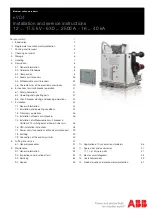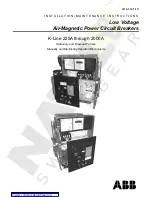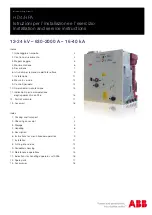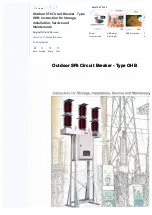
ABB | SACE Emax 2
Putting into service and maintenance | 6 - Decommissioning and treatment at end of life
73 | © 2019 ABB | 1SDH001000R0002 - ECN000109166 - Rev. D
6 - Decommissioning and treatment at end of life
Safety standards
During the early stages of the process of decommissioning and end of life treatment of SACE Emax 2 circuit-
breakers, observe the following safety rules:
• the closing springs, even if discharged, must never to be taken apart
• for handling and lifting of the circuit-breakers refer to the section "Unpacking and handling" on page 10 .
HAZARD! RISK OF ELECTRIC SHOCK! Unplug or disconnect any power supply, to
avoid any potential risk of shock during removal of the circuit-breaker from the
service.
WARNING! After dismantling the switchgear, the circuit-breaker must be stored in
the open position with the closing springs discharged and with the front cover
mounted.
Trained personnel
The operations for decommissioning SACE Emax 2 circuit-breakers involve performing procedures that
can be performed by Trained Persons in the electrical field (IEV 195-04-02: person adequately advised or
supervised by electrically skilled persons to enable him or her to perceive risks and to avoid danger which
electricity can create).
End of life treatment for circuit-
breaker materials
The materials used in the production of SACE Emax 2 circuit-breakers are recyclable and should be treated
separately as shown in the following table:
TYPE
MATERIAL
A
Plastic parts
(1)
B
Metal parts
C
Printed circuits
D
Current sensors, cables, motors, electrical windings
(1)
All the components of significant dimensions bear a mark specifying the type of material.
NOTE:
refer to the national legislation in force at the time of decommissioning of the product,
in the case where it specifies end of life treatment procedures different from those indicated.
Disposal of packing materials
The materials used for the packaging of SACE Emax 2 circuit-breakers are recyclable and should be treated
separately as shown in the following table:
TYPE
MATERIAL
A
Plastic parts
B
Cardboard parts
C
Wooden parts
D
Metal parts
NOTE:
refer to the national legislation in force at the time of decommissioning of the product,
in the case where it specifies end of life treatment procedures different from those indicated.



































